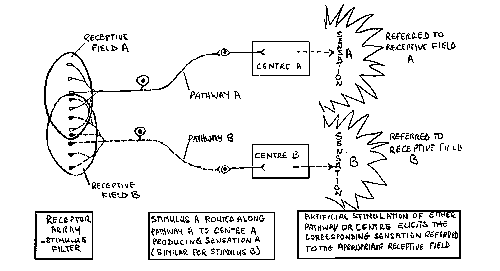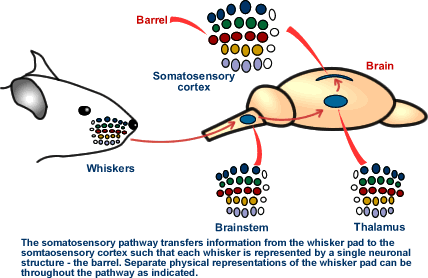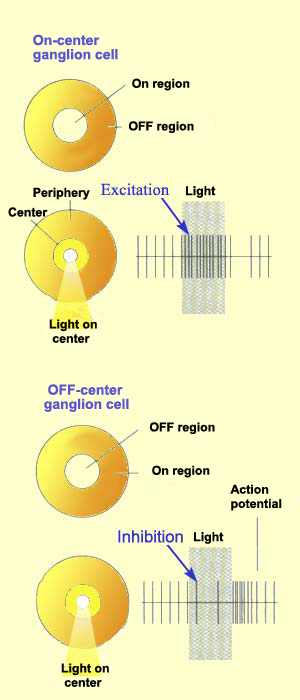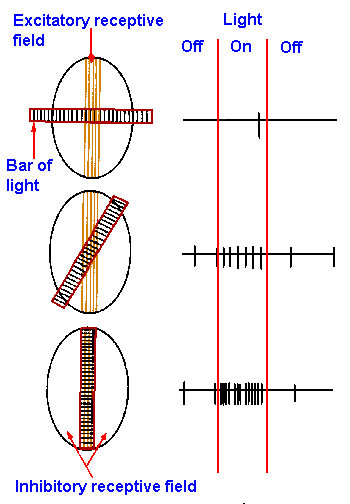BIO254:ReceptiveField
Introduction
Receptive fields are regions of space where a stimulus causes a particular sensory neuron to respond. The concept of the receptive field was first introduced by Sir Charles Sherrington in relation to reflex actions. Receptive fields are known to exist in the somatosensory, visual and auditory system. For example, a neuron in a somatosensory map might respond to pressure on a particular patch of skin, or a neuron in the visual cortex to a particular portion of the retina. Yet neurons have functional receptive fields that are more abstract than simple spatial patches.
The density of receptors plays a role in determining the size of the receptive field: dense populations of receptors tend to have small receptive fields, and as a result, finer resolution of detail. The resolution of a sensory system is not uniform everywhere. In addition, as information is passed from one neuron to the next, the receptive field of each neuron may change. This depends upon the cells converging on it. As a consequence, the receptive fields of higher order nuclei are larger and more complex.
Somatosensory System
The mechanoreceptors in the skin have receptive fields that overlap with each other. When a point on the skin is touched, the tactile stimulus generates spikes at the node of Ranvier which are conducted to reach the nerve terminals.

There are three relay sites between mechanoreceptors in the skin and the cerebral cortex. Cortical neuron responses are processed in the dorsal column nuclei, the thalamus, and the cortex. Cortical neurons are studied using extracellular recording.
Every point on the skin is represented in the cortex by cortical cells connected to the receptors that are activated when that point on the skin is touched. Cortical neurons are grouped by function, with receptive fields arranged in an orderly topographic sequence that forms a map of the body.
Receptive fields in higher cortical regions are larger. In relay neurons, cortical receptive fields depend on divergent presynaptic connections and convergent postsynaptic connections.

When the skin is touched at two or more points simultaneously, regions of skin surrounding the excitatory region of a receptive field of a cortical neuron will suppress excitation to another stimulus because the area surrounding the excitatory region is inhibitory. This is also known as the inhibitory surround.
Visual System
In the visual system, light enters through the pupil and is focused by the lens onto the retina. This light activates photoreceptors in the retina, which synapse onto bipolar cells, which synapse onto retinal ganglion cells. The retinal ganglion cells then send their axons to the lateral geniculate nucleus of the thalamus. These cells then send their axons to the primary visual cortex. Beginning with the retinal ganglion cells, the neurons possess distinct receptive fields, changing as the neurons progress to the cortex. These receptive fields are described below.
Retinal Ganglion Cells

The receptive areas of retinal ganglion cells (RGCs) are circular, and divided into two parts, the receptive field center and the surround. On-center RGCs are excited when light is at the center of the receptive field, and are inhibited when light is on the surround. Off-center RGCs are inhibited by light at the center of their receptive field, and are excited when light is on the surround. Thus, they begin to analyze the pattern of incoming light.
In an on-center RGC, the bipolar cell synapsing onto it is depolarizing. In an off-center RGC, the bipolar cell synapsing onto it is hyperpolarizing. The concentric nature of the receptive field is created by the inhibitory, hyperpolarizing horizontal cell in the surround.
RGCs have two functional classes, M and P. M cells have large receptive fields, respond to large objects, and have rapid changes in stimulus. P cells have small receptive fields, are in larger numbers, respond to specific wavelengths, and are involved in the perception of form and color.
The receptive fields of RGCs vary in size. Receptive fields are small in the foveal region of the retina and large at the periphery of the retina. The firing rate of a RGC determines constrast in light between the center and surround.
Cells in the Lateral Geniculate Nucleus of the Thalamus
Ganglion cells then send their axons to the lateral geniculate nucleus (LGN) of the thalamus, whose cells have similar concentric on- or off-center receptive fields. These neurons then send their axons to the primary visual cortex.
Simple Cells in the Primary Visual Cortex

Simple cells respond to bars of light with a specific orientation. This receptive field is formed from the simultaneous input of aligned LGN cells. The LGN cells have receptive fields whose overlap forms a longitudinal bar with a specific orientation.
Complex Cells in the Primary Visual Cortex
Complex cells respond to edges in a specific orientation. This receptive field is formed from the parallel input from simple cells in the same orientation. There are no clear on or off areas.
Auditory System
Receptors in the auditory system are spatially distributed according to the sound frequencies that they respond to. High frequencies are located at the base of the cochlea and low frequencies at the apex.
References
1. Hubel, D.H., Wiesel, T.N., "Receptive fields, binocular interaction and functional architecture in the cat's visual cortex" (Journal of Physiology, 160, 106-154)
2. Kandel, E.R, Schwartz, J.H, and Jessel, T.M., " Principles of Neural Science, Fourth Edition" (McGraw Hill, 2000)
3. Moore, C.I., Nelson, S.B., Sur, M. "Dynamics of Neuronal Processing in Rat Somatosensory Cortex" (Trends in Neurosciences 22, 1999, 513-520)
4. Mirabella, G., Battiston, S., and Diamond, M.E. "Integration of multiple-whisker inputs in rat somatosensory cortex" (Cerebral Cortex 11, 164-170)
5. Worgotter, F., and Holt, G. "Spatial-temporal mechanisms in receptive fields of visual cortical simple cells" (J. Neurophysiol, 1991, 494-510)
